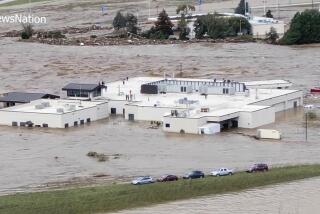In Tennessee, cleanup and worries
- Share via
ROANE COUNTY, TENN. — The gunk on the water had thinned to a gray scrim in front of Mike Thomas’ riverfront home -- a small sign of progress one week after one of the worst coal ash spills in American history.
But as Thomas drove along the bluff over the Emory River, he pointed to big piles of sludgy, dark gray ash, a byproduct of coal combustion, that had been accidentally disgorged by the nearby electricity plant. The heaps jutted from the water’s surface like ugly volcanic islands. By the shore, many neighbors’ docks sat in ruins, destroyed by mammoth waves when the ash was released.
This wasn’t what Thomas had in mind when he bought his retirement home nine years ago.
“It’s like something you’d see in Cleveland or damned Newark, New Jersey,” said Thomas, a 62-year-old Georgia native. “Not east Tennessee.”
This week, hundreds of workers continued a massive cleanup around the Kingston Fossil Plant, a Tennessee Valley Authority facility that has been a mundane and welcome fixture here for the last half a century, until -- late at night and three days before Christmas -- it became a force of ruination. Earthen walls surrounding one of the plant’s retention areas failed, sending more than a billion gallons of the ash -- enough to fill 1,500 Olympic-sized swimming pools -- coursing into surrounding waterways and a handful of private properties.
No one was harmed, but residents are worried about the long-term health effects from the ash, which contains potentially harmful contaminants such as arsenic. They are also worried about the threats to their economy and culture, long defined by the picturesque waterways that snake through the lush Appalachian hill country.
“We’re worried about the arsenic and whatever other contaminants are in the water, and we’re worried about anything getting airborne,” Thomas said. “On a lower level, we’re worried about recreation -- hunting, boating, fishing.
“And property values,” he added, gesturing to a home that serves as an appendage to an expansive deck overlooking the quiet river. “This is my legacy to my children.”
State and federal officials Wednesday were awaiting results of soil testing. Preliminary air tests show no problems, although windy weather could change that. Meanwhile, some water samples taken close to the ash piles have found levels of arsenic and other pollutants that exceed drinking water standards. Officials are monitoring private wells, and say drinking water in municipal systems is safe -- for now.
Company officials have not determined the cause of the wall failure. Nor can they say how long the cleanup will take, or how much it will cost.
With so many unanswered questions, life in this county of 54,000 people has entered an unpleasant state of limbo. Health officials have advised residents to stay away from the ash, and to wash their hands thoroughly if they do get around it. The county school system altered its bus routes to keep a safe distance from the spill. Recreational boating has been suspended on the Emory River, parts of which have been rendered impassable.
Residents like Jeff Spurgeon who built waterfront dream homes now find themselves steps away from a man-made ecological nightmare.
“It’s devastating, it really is,” said Spurgeon, 43. The phone company worker and his wife saved for years to build the 4,400-square foot brick home along a cove that has become, literally, a giant ashtray.
The disaster carries a hint of irony for longtime residents: If there was a concern about ecological threats, it came from a few miles south, where the TVA operates a nuclear plant; or a few miles northeast around the Oak Ridge National Laboratories, where a cleanup of nuclear arms production sites has dragged on for years.
The spill also promises to test the store of goodwill built up over the decades by the TVA, the mammoth federally owned utility created during the Depression to provide energy, flood control and economic development to a large swath of the rural South.
TVA measures brought stability to the three rivers that meet here -- the Emory, the Clinch and the Tennessee -- which were subject to deadly flooding. A dam to the south broadened the rivers’ contours, helping popularize the area as a fishing and boating spot. More recently, waterfront real estate attracted retirees from around the country. The local economic development agency distributes brochures of lake scenes, with a now unfortunate slogan: “Overflowing with possibilities.”
The utility completed the coal-powered electricity plant near the confluence of the three rivers in the mid-1950s. It was welcomed as a major employer, and it earned a reputation for safety. But residents like Spurgeon watched with some trepidation as the pile of ash next to the plant grew year after year, finally towering higher than 50 feet.
“I kind of wondered, ‘How high can it go?’ ” he said. “Accidents happen, but I think this could have been prevented.”
Others complained that the TVA was conducting much of the early testing, and raised questions about the trustworthiness of its data.
John Moulton, a TVA spokesman, said the ash pile was stored according to state regulations and monitored regularly. The Environmental Protection Agency, the Tennessee Department of Environment and Conservation, and the local water utilities have gotten more involved in testing for contaminants.
The company, meanwhile, has been busy cleaning up the mess -- and placating worried locals.
An army of roughly 200 workers has been called in on cleanup duty. The ash is being hauled away with earth-moving equipment, including amphibious trackhoes -- huge scooping machines outfitted with tank-like treads. On the river, a rock weir -- an underwater wall -- is being built to keep the sunken ash from floating downstream, and a system of floating booms is corralling harmless but unattractive silica particles called cenospheres that float on the surface.
“At the end of the day,” plant manager Ronald Hale said, “we want everyone to know it’s clean.”
TVA employees and retirees have canvassed the area asking after residents. Thomas, the retiree, said he had already been visited twice by TVA representatives, and his property was not damaged.
The effort has failed thus far to stem what could be a tide of litigation. This week, the Southern Alliance for Clean Energy, an environmental nonprofit, filed notice of its intent to sue TVA under the federal Clean Water and Resource Conservation and Recovery acts. Four property owners have also reportedly sued the TVA in state court, seeking $165 million in damages.
Realtor Ron Hillman of Sail Away Homes and Land, a specialist in riverside property, said the question for his business and the county was whether the water proves clean enough to swim in and drink.
“If [the results] are negative, this time next year we could be doing something different for a living -- it could put us out of business,” he said. “Right now we’re keeping a positive attitude.”
--
More to Read
Sign up for Essential California
The most important California stories and recommendations in your inbox every morning.
You may occasionally receive promotional content from the Los Angeles Times.










